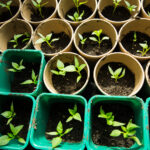Seeds sprout through a process called germination. Different vegetables have different germination requirements. It’s important to know the germination requirements of the seeds you are planting to ensure success.
Germination–depending upon the type of seed–requires just the right conditions for growth–usually an abundant supply of water, an adequate supply of oxygen, and the proper temperature. Water causes the seed’s tissue to swell and break through the seed coat. Oxygen supports respiration, the burning of food stored in the seed necessary to supply the energy to grow. The correct temperature provides the optimal environment for growth.
A seed is viable if it is able to germinate under the proper conditions for that seed. Seed viability can range from a few weeks to 50 years. Most vegetable seeds are viable for up to three years, but not all.
Viable seeds are alive; they contain an embryo, stored food, and are surrounded by a seed coat. A seed will germinate or begin to grow when soil moisture, temperature, and oxygen, as well as light conditions, are right for that specific seed.
Good Products for Seed Starting Success at Amazon:
- Espoma Seed Starting Mix
- 200 Count- Jiffy 7 Peat Soil Seed Starting Plugs
- Seed Starter Kit with Humidity Dome (120 Cells Total Tray)
Some vegetable seeds have special requirements to germinate. They are protected by seed dormancy—that is they require special circumstances beyond what we might consider normal germination requirements. Seed dormancy is genetic and the product of a specific plant species’ adaptation to its natural environment over thousands of years.
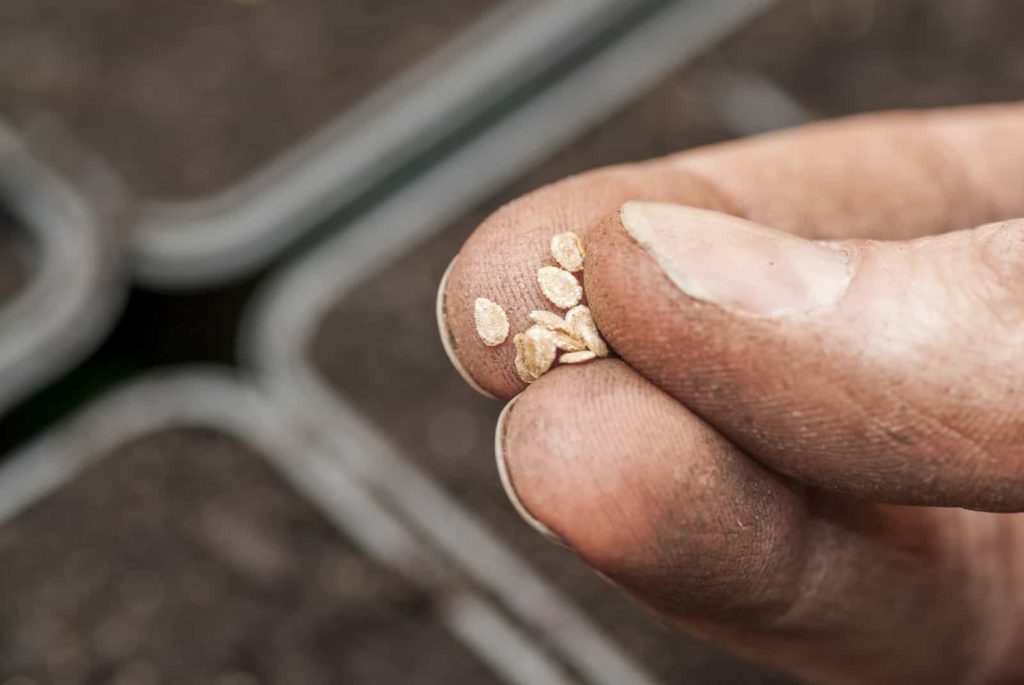
Normal vegetable seed germination requirements
- Nearly all vegetable seeds will germinate at about 60° to 70°F (16-21°C) if they are in contact with moist, aerated soil; the soil should be moist to about 50 to 75 percent of the soil’s moisture-holding capacity–that is moist, not wet. Many vegetable seeds—generally cool-weather crops—will germinate in the soil as cool as 45° to 50°F (7-10°C) —a few in even cooler soil.
- All seeds should be planted in fine-textured soil. That is humus-rich loamy soil that contains a well-decomposed organic matter. Fine-textured soil is well aerated which allows for good gas exchange between the embryo of the germinating seed and the soil. (Seeds like people need oxygen; oxygen is partially converted to carbon dioxide during growth; the carbon dioxide needs to move away from the seed through aerated soil.)
- Soil for seed starting should be just moist; moisture is needed by most seeds for the seed coat to swell and open; water is essential for seeds and plants to transport nutrients throughout the seed and plant.
- Most vegetable seeds should be planted to a depth that is 3 times the thickness of the seed. For example, a bean seed as large as 1 inch wide should be planted 3 inches deep. A carrot seed that is ¼ inch wide should be planted ½ inch deep.
- Seeds started indoors are best sown in a sterile, soilless seed starting medium. A sterile mix can help avoid damping-off—the fungal disease that can cause seedlings to collapse. Soilless mixes commonly contain some combination of aged compost, perlite, and vermiculite. Once seedlings develop their first set of true leave, begin fertilizing them with a weak solution of fish emulsion on a regular basis. Seed starting mixes contain few nutrients.
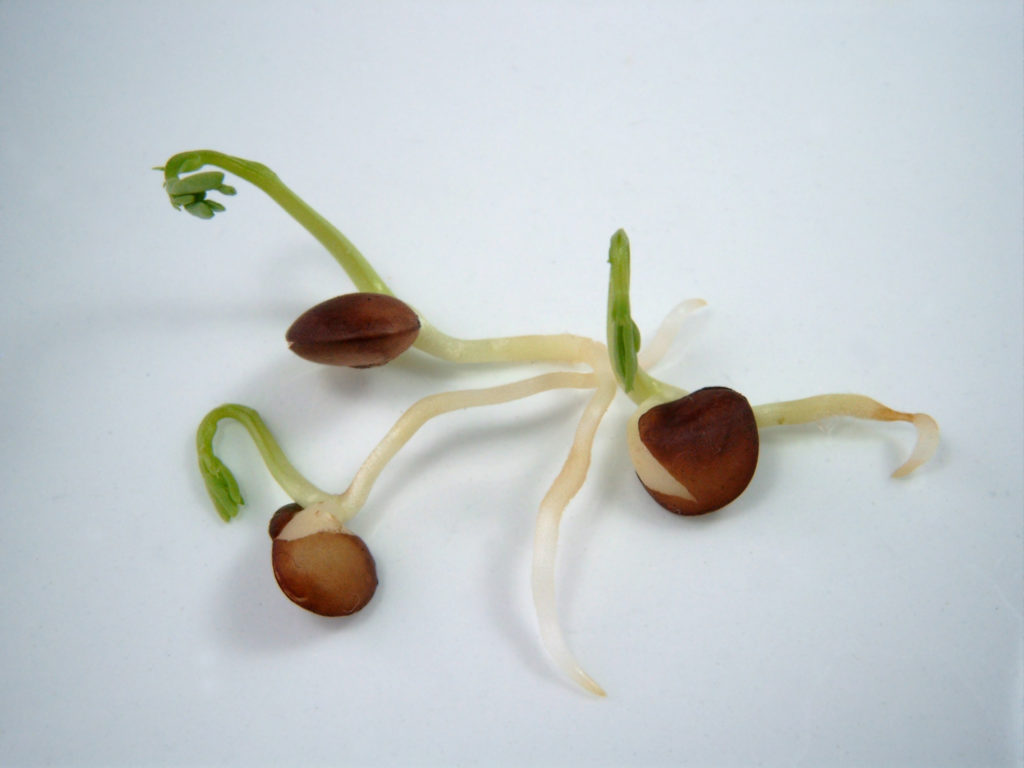
The process of seed germination explained
- A seed has everything needed to make a new plant; it waits until environmental conditions are met: an ample supply of water, optimum temperature, and the situation in well-aerated soil or other media.
- Less than 2 percent of a seed’s weight is water; by comparison, 95 percent of a mature herbaceous plant is water. Low water content protects a seed against damage from low temperatures, for example, water in a seed could freeze, expand, and damage the seed.
- Water absorbed by a seed causes the seed coat or shell to expand and split which in turn allows the seed embryo and cotyledons or seed leaves access to oxygen in the soil. Oxygen is needed for germination chemistry to proceed.
- Germination chemistry causes food molecules in the seed–starch, protein, and fats–to break down into sugars and amino acids which allow for the construction of new plant cells including a root that anchors the new plant and draws life-producing minerals and moisture from the soil. An embryonic shoot grows and pulls the seed leaves or cotyledons through the soil.
- When the seed leaves reach through the soil to light, photosynthesis begins and produces all the food the plant requires to grow to maturity.
- Germination ends when the shoot emerges from the soil.
What seeds typically need for germination
Light
Some seeds such as beans need darkness in order to germinate; other seeds such as lettuce need light. Seeds that require darkness should be covered with fine soil or vermiculite to a depth equal to twice the seed’s diameter. Seeds that need light can be just sprinkled with a seed-starting mix.
Media
All seed-starting mediums whether a soil mix or vermiculite should be loose and smooth. Outdoor seedbeds should be well-worked.
Temperature and moisture
Soil and air temperatures should be near the optimum for the crop and so should the soil moisture.
Temperatures too low or too high can damage or kill seedlings; the optimal soil temperature for germinating most vegetables is between 65° and 70°F.
The same is true for soil moisture; generally, a soil mix that is not too dry and not too wet but just moist is best.

Vegetable seed germination temperatures
Vegetable seed germination is greatly dependent upon soil temperature. Other near-equal factors include seed vitality (the age of the seed), soil moisture, soil air, and soil conditions and workability.
This chart shows the range of soil temperatures needed for seed germination. The chart also shows the number of days to germination at optimum temperatures. A seed will germinate at temperatures between the minimum soil temperature and the optimum soil temperatures, but the number of days to germination will be greater.
Use this chart to determine if the soil temperature in the garden is right for seed starting the crop you want to plant. (Use a soil thermometer to take the soil temperature.) If the outdoor soil temperature is not right, you can likely start the seed indoors at near optimum temperature
| Crop | Germination minimum soil temperature (°F) | Germination optimum soil temperature range (°F) | Germination maximum soil temperature (°F) | Days to germination at optimal temps | |||
| Asparagus | 50 | 60-85 | 95 | 14-18 | |||
| Bean, lima | 60 | 75-85 | 85 | 4-10 | |||
| Bean, snap | 60 | 75-85 | 95 | 4-10 | |||
| Beet | 40 | 60-85 | 95 | 4-10 | |||
| Broccoli | 40 | 60-85 | 95 | 7-10 | |||
| Brussels sprouts | 40 | 60-85 | 95 | 3-10 | |||
| Cabbage | 40 | 60-85 | 95 | 5-10 | |||
| Carrot | 40 | 65-85 | 95 | 6 | |||
| Cauliflower | 40 | 65-85 | 95 | 4-10 | |||
| Celery | 40 | 60-70 | 95 | 10 | |||
| Chinese cabbage | 40 | 60-85 | 95 | 4-10 | |||
| Collards | 40 | 60-85 | 95 | 5-10 | |||
| Corn | 50 | 65-95 | 105 | 4-10 | |||
| Cucumber | 60 | 65-95 | 105 | 5-7 | |||
| Eggplant | 60 | 75-85 | 95 | 10-15 | |||
| Endive | 35 | 60-75 | 85 | 10-14 | |||
| Garlic | 35 | 65-85 | 95 | 7-14 | |||
| Kale | 40 | 60-85 | 95 | 5-7 | |||
| Kohlrabi | 40 | 60-95 | 105 | 5-10 | |||
| Leeks | 35 | 65-85 | 95 | 8-16 | |||
| Lettuce | 35 | 60-75 | 85 | 2-10 | |||
| Muskmelon | 60 | 75-95 | 105 | 4-10 | |||
| Mustard | 35 | 60-75 | 85 | 4-6 | |||
| Okra | 60 | 85-95 | 105 | 7-12 | |||
| Onion | 35 | 65-85 | 95 | 4-12 | |||
| Parsley | 40 | 65-85 | 95 | 5-6 weeks | |||
| Parsnip | 35 | 65-75 | 85 | 5-28 | |||
| Pea | 40 | 65-75 | 85 | 5-7 | |||
| Pepper | 60 | 65-75 | 95 | 7-10 | |||
| Pumpkin | 60 | 85-95 | 105 | 4-10 | |||
| Radicchio | 35 | 60-75 | 85 | 5-7 | |||
| Radish | 40 | 65-85 | 95 | 4-10 | |||
| Spinach | 35 | 65-75 | 75 | 6-14 | |||
| Squash | 60 | 85-95 | 105 | 7-10 | |||
| Swiss chard | 40 | 65-85 | 95 | 7 | |||
| Tomato | 50 | 65-85 | 95 | 5-7 | |||
| Turnip | 40 | 60-95 | 105 | 3-10 | |||
| Watermelon | 60 | 70-95 | 105 | 4-10 |
For specific seed starting requirements for the crop, you want to grow, seed-specific crop seed starting directions. Go to the Index to find your crop or see Seed Starting Specific Crops also in the Index.

Exceptions to normal germination requirements
Some vegetable seeds have special germination requirements. For seed sowing success, here are exceptions you should know:
Seeds that need light to germinate
- Some vegetable seeds—mostly very small ones—require light–not darkness–to germinate. The seeds from these plants are usually very small and naturally, drop from spent flowers or drop to the soil in rotting fruits.
- Seeds that require light to germinate are lettuce and savory. These seeds should not be covered with soil or just barely. Press these seeds into the soil with your finger or thumb so that the seed is just surrounded but not covered with soil. Keep the soil just moist and protect these seeds from drying sun, wind, and foraging birds by covering the seedbed with a light floating row cover.
- Seeds that need little soil cover to germinate are broccoli, Brussels sprouts, cabbage, cauliflower, Chinese cabbage, collards, cucumbers, eggplants, kale, kohlrabi, leeks, melons, peppers, squashes, and tomatoes. These seeds can germinate in light if surrounded by moist soil or they can be lightly covered with soil.
Seeds for Success at Amazon:
Seeds that benefit from soaking in water
- Some seeds germinate quicker if they are soaked in water or water and a drop of vinegar before they are planted. Seeds with hard coats, big seeds, and seeds with wrinkled coats benefit from soaking in water before planting.
- These seeds include asparagus, beans, carrots, corn, okra, parsley, peas, pumpkins, and squash. Beet seeds and Swiss chard seeds will benefit from soaking in water also.
- Put these seeds in a shallow bowl of water or place them on a damp paper towel and put them in a sealed plastic bag to soak up the moisture.
- Warm water will reduce the soaking time.
- Add a few drops of kitchen vinegar to the water; the acid in the vinegar will also help break down the seed coat.
- Soak these seeds just long enough for the seed coats to draw up moisture—about 12 hours or overnight.
Seeds that benefit from being scratched or nicked
- Seeds with very hard coats will germinate more quickly if the seed coat is scratched or nicked and then soaked in water before planting. This process is called scarification.
- Seeds that can benefit from light scratching before planting include beans, melons, and squashes.
- Scarification should weaken the seed coat so that moisture is more easily soaked up. Do not puncture the seed coat; this can kill the seed embryo.
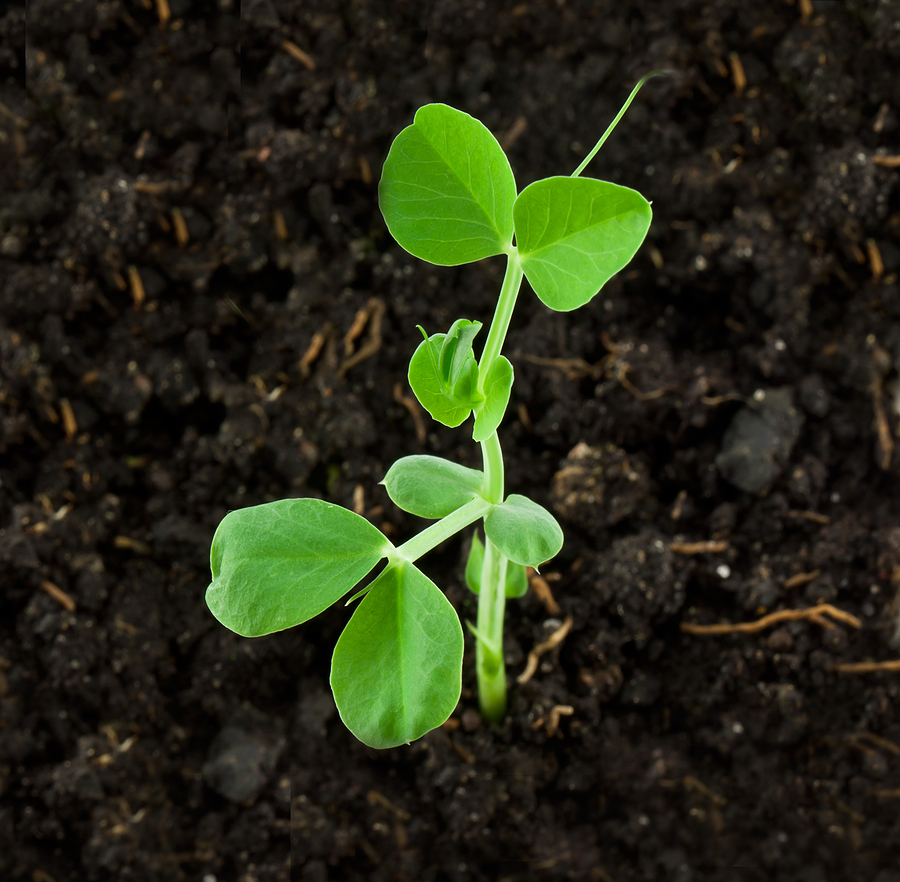
Seeds that germinate in cool soil
- Most cool-weather vegetables have naturally adapted to germinate best in cool not very warm soil.
- Seeds best planted early in cool soil include arugula, broccoli, Brussels sprouts, cabbage, carrots, cauliflower, Chinese cabbage, collards, garden cress, kale, kohlrabi, leeks, lettuce, mustard, onions, parsley, parsnip, peas, radish, spinach, and turnips.
- Herbs that prefer to be planted early in cool soil include borage, chamomile, chervil, coriander, dill, marjoram, and thyme.
Seedlings that resent transplanting
- The roots of some seedlings do not take well to transplanting.
- Vegetables and herbs best started in place in the garden include anise, arugula, borage, carrots, chervil, coriander, dill, fennel, mustard, parsley, parsnips, peas, radish, rutabaga, spinach, Swiss chard, and turnips.
- If you start these crops indoors and transplant them out to the garden, just nip off the tip of the root before transplanting. Tipping the end of the root will allow long roots to fit in the planting hole.
Pre-sprouting seeds to test the viability
Pre-sprouting vegetable seeds will help you answer the question: Is this seed still viable?
To pre-sprout seeds place the seeds on a damp paper towel. Make sure that the seeds are well-spaced and not touching one another. Fold the towel in half. Alternatively, place the seed on a damp paper towel and then place a second damp paper towel on top. Next place the paper towel with seeds in a small plastic bag. Place the plastic bag on top of the refrigerator or on top of a hot water heater or other warm spot and wait for germination.
There are many reasons seeds may not germinate: the seed is too old; the soil or starting mix is poor; the soil was not watered before sowing; there’s insufficient light or warmth for the seed to begin growing.
Once the seeds are in the plastic bag and set in a warm place, check for sprouting every two or three days. When the seeds sprout, lift the new seedlings with tweezers or your fingers and gently transplant them into a moist planting medium in small pots. Don’t allow roots to begin growing on the moistened paper towel; they will become very difficult to remove.
Pre-sprouting seed on moist paper towels is ideal for small seeds. Larger seeds can be pre-sprouted on a moistened paper coffee filter. The moistened filters and seed can be placed upright in a clear plastic kitchen container until sprouting.
Seed viability and shelf life
Seed viability or shelf life is an important concept. If you saved seed from last season or the season before or if you’ve been given seed and are not sure how long it’s been around, you might want to perform a seed vitality test a couple of weeks before you plan to sow.
Seeds more than a year or two old may not germinate well or at all, particularly if they have not been stored properly. Some seeds, even after a year of proper storage, may not produce the number of plants you expect or need.
Are the seeds you have on hand still viable–will they germinate?
A seed contains an embryo–a partly developed root and stem, a supply of stored food, and a protective coating. Many seeds are viable for several years; some are viable for only a year or two. If a seed’s protective coating or the partly developed root or stem are damaged, or if its food supply dissipates with time, the seed will no longer be viable and will not germinate.
Good Products for Seed Starting Success at Amazon:
- Espoma Seed Starting Mix
- 200 Count- Jiffy 7 Peat Soil Seed Starting Plugs
- Seed Starter Kit with Humidity Dome (120 Cells Total Tray)
Seed life of vegetable crops
Here is a short guide to how long some vegetable seeds are viable:
- 1-2 years: carrots, celeriac, celery, corn, leeks, onions, parsnip, scallions, shallots
- 3-4 years: beans, beets, broccoli, Brussels sprouts, cabbage, collards, eggplant, kale, lettuce, peas, peppers, pumpkins, squash, tomatoes.
- 5-6 years: cucumbers, melons, radishes, spinach
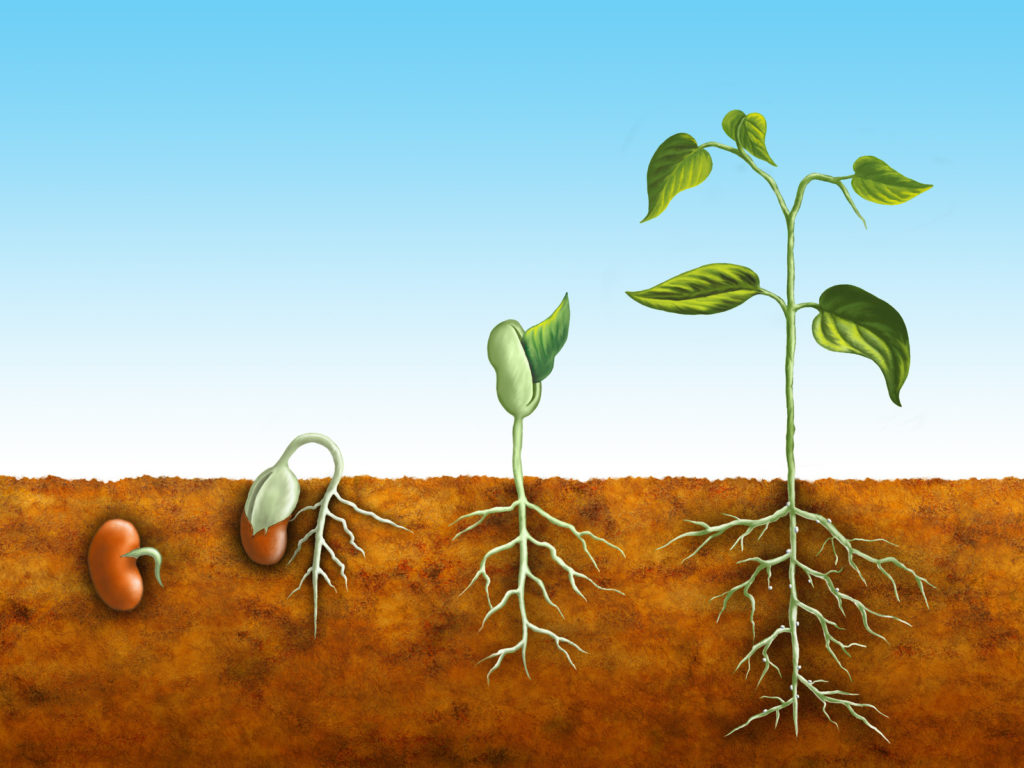
Seed germination process
Seeds sprout through a process called germination. Germination–depending upon the type of seed–requires just the right conditions for growth–usually an abundant supply of water, an adequate supply of oxygen, and the proper temperature. Water causes the seed’s tissue to swell and break through the seed coat. Oxygen supports respiration, the burning of food stored in the seed necessary to supply the energy to grow. The correct temperature provides the optimal environment for growth.
A seed is viable if it is able to germinate under the proper conditions for that seed. Seed viability can range from a few weeks to 50 years. Most vegetable seeds are viable for up to three years, but not all.
Old seeds may not germinate
If you have seed leftover from last season or the season before or if you have been given seed and are unsure how old the seed might be, testing seed viability can save you time and effort in the garden. Seeds can require a few days to more than a week or two to germinate; if you sow a seed today and it fails to germinate in a week or two, you have lost time and wasted your effort.
Seeds more than a year old or seeds that have been improperly stored–usually in a warm or humid place (seed should be stored in a dry place at temperatures just above freezing) may have lost s
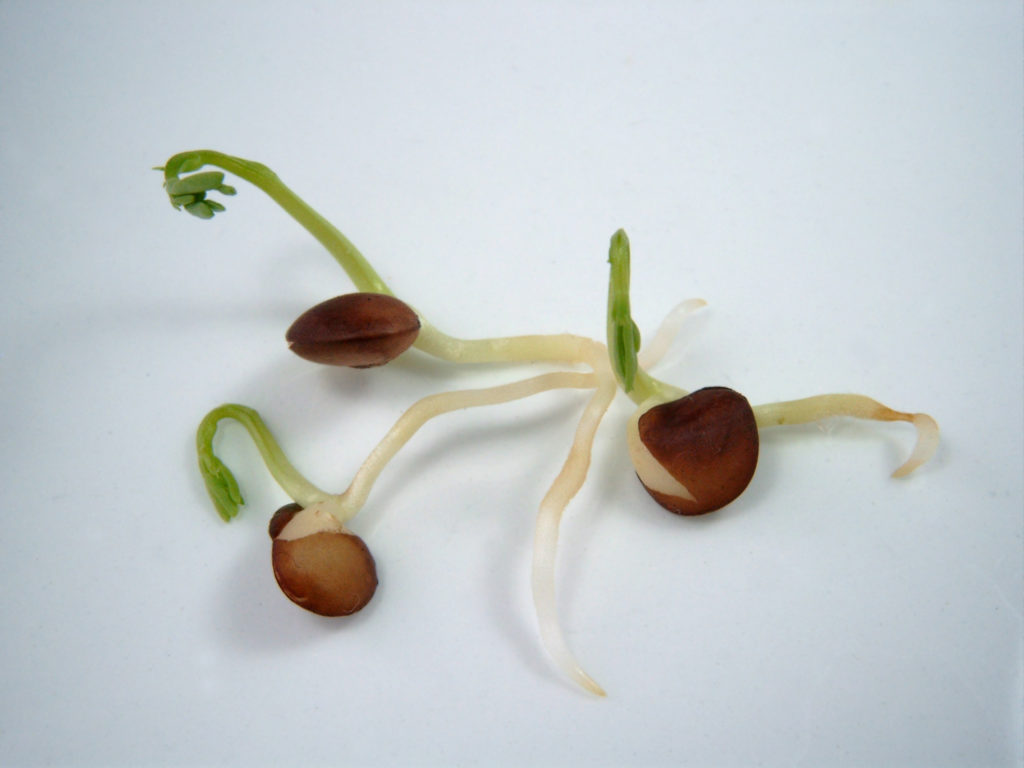
Seed viability test
A simple check of seed viability can save you time and effort. Here’s a simple way to test germination and also estimate the rate of germination for the seed you have on hand:
Take a paper towel and write the name of the seed on it and the number of days to germination (you can get this number from the back of the seed packet or from a grower’s guide). Moisten the paper towel and count out 10 or 20 seeds onto the towel. Fold the moist towel so that both sides make contact with the seeds. Place the folded towel in a plastic bag or food storage baggie and seal it. Place the bag in a bright, warm (70°F) place and wait for the number of days required for germination.
After the average number of days to germination, unwrap the towel and count the number of seeds that have germinated. If none have sprouted re-wrap the towel and replace it in the glass and wait several more days. If seeds have sprouted, count the number of sprouts and divide by the total number of seeds on the towel. That will give you a good estimate of the germination rate for that batch of seeds and the success you can expect when you sow in the garden.
Some seeds need light, not dark, to germinate. To test seeds that are supposed to be sown on the soil surface, place the seed on the moistened paper towel but do not fold it. Just slip the moist towel and seed into the plastic bag and count the number of days to germination.
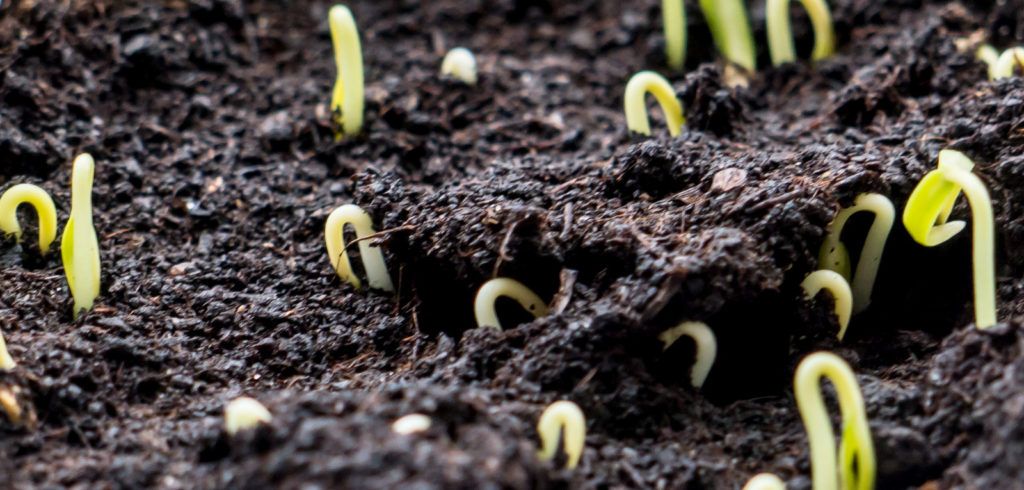
Seed germination rate
For most seeds, a germination rate of 90 percent or greater is very good. Some plant varieties may have lower germination rates, but because the seed is small and/or abundant, a rate of 70 to 80 percent is acceptable.
If the germination rate is low, buy new seeds or plant more of the old seeds than you would normally to make up for the low rate of germination. (Divide the number of sprouted seeds into the total number of seeds to get your germination rate for the total batch of seeds.) Seed packets–in addition to listing the number of days to germination–will often state the expected rate of germination.
Storing unused seed
Buying new seeds each year will ensure optimal germination and stronger plants, but the large amount of seed in seed packets is usually more than a gardener will need in a given year. Extra seeds can be put away until next year and should remain viable. Store extra seed in a dry jar with a tight-fitting lid and place it in the refrigerator away from the freezer section.
Keep in mind, seeds more than a year or two old may not germinate well or at all, particularly if they have been stored improperly.
Shelf life for some vegetable seeds
Asparagus:
- Rate of germination at 1 year: 90%
- Years seeds will germinate: 3
- Days to germination: 14-21
- Seeds per ounce: 1,000
Beans:
- Rate of germination at 1 year: 90%
- Years seeds will germinate: 3
- Days to germination: 6-15
- Seeds per ounce: 90-100
Cabbage:
- Rate of germination at 1 year: 85%
- Years seeds will germinate: 4
- Days to germination: 10-14
- Seeds per ounce: 5,000
Carrots:
- Rate of germination at 1 year: 75%
- Years seeds will germinate: 3
- Days to germination: 14-21
- Seeds per ounce: 14,000
Cauliflower:
- Rate of germination at 1 year: 75%
- Years seeds will germinate: 4
- Days to germination: 10-14
- Seeds per ounce: 14,000
Sweet Corn:
- Rate of germination at 1 year: 85%
- Years seeds will germinate: 3
- Days to germination: 5-7
- Seeds per ounce: 125
Cucumber:
- Rate of germination at 1 year: 85%
- Years seeds will germinate: 5
- Days to germination: 7-10
- Seeds per ounce: 1,000
Eggplant:
- Rate of germination at 1 year: 75%
- Years seeds will germinate: 4
- Days to germination: 7-14
- Seeds per ounce: 5,000
Lettuce:
- Rate of germination at 1 year: 90%
- Years seeds will germinate: 6
- Days to germination: 12,000
- Seeds per ounce: 7-10
Muskmelon:
- Rate of germination at 1 year: 85%
- Years seeds will germinate: 5
- Days to germination: 6-10
- Seeds per ounce: 1,200
Mustard:
- Rate of germination at 1 year: 85%
- Years seeds will germinate: 3
- Days to germination: 8-12
- Seeds per ounce: 18,000
Okra:
- Rate of germination at 1 year: 85%
- Years seeds will germinate: 1
- Days to germination: 10-14
- Seeds per ounce: 425
Onions:
- Rate of germination at 1 year: 80%
- Years seeds will germinate: 2
- Days to germination: 7-14
- Seeds per ounce: 12,500
Parsnip:
- Rate of germination at 1 year: 85%
- Years seeds will germinate: 1
- Days to germination: 21-27
- Seeds per ounce: 600
Peas:
- Rate of germination at 1 year: 90%
- Years seeds will germinate: 3
- Days to germination: 7-10
- Seeds per ounce: 50-150
Pepper:
- Rate of germination at 1 year: 75%
- Years seeds will germinate: 2
- Days to germination: 10
- Seeds per ounce: 4,000
Pumpkin:
- Rate of germination at 1 year: 90%
- Years seeds will germinate: 4
- Days to germination: 7-10
- Seeds per ounce: 100
Radish:
- Rate of germination at 1 year: 90%
- Years seeds will germinate: 4
- Days to germination: 4-6
- Seeds per ounce: 5,000
Spinach:
- Rate of germination at 1 year: 80%
- Years seeds will germinate: 3
- Days to germination: 8-12
- Seeds per ounce: 3,000
Tomato:
- Rate of germination at 1 year: 85%
- Years seeds will germinate: 3
- Days to germination: 5-7
- Seeds per ounce: 6,000-7.500
Vegetable seeds per ounce
Vegetable seeds for home gardens are often sold by weight–by the ounce or by the gram or by fractions of ounces and grams.
Some seed sellers sell by the piece–1 seed per penny, for example. But seeds sold in packets–especially those sold in stores–commonly list the weight, but not the number of seeds.
When buying seed by weight, keep in mind the following:
• The weight of a number of seeds for a specific vegetable crop can vary by variety or cultivar.
• One ounce equals 28 grams.
Estimated number of vegetable seeds by the ounce or gram:
Here are estimates of the number of seeds in an ounce or gram by crop. These estimates are based on a survey of several seed sellers. (These are estimates. To be certain of the number of seeds in a seed packet sold by weight, count the seed.)
- Artichoke: 200 seeds per ounce; 7-8 per gram.
- Arugula: 14,200 seeds per ounce; 500 seeds per gram.
- Asparagus: 680-1400 seeds per ounce; 24-50 seeds per gram.
- Basil: 17,000-18,400 seeds per ounce; 600-650 seeds per gram.
- Broad Beans: 25-30 seeds per ounce; 1 seed per gram.
- Bush Beans: 50-280 seeds per ounce; 2-10 seeds per gram.
- Pole Beans: 25-30 seeds per ounce; 1 seed per gram.
- Beets: 1134-1700 seeds per ounce; 40-60 seeds per gram.
- Broccoli: 9000 seeds per ounce; 315 seeds per gram.
- Brussels sprouts: 7600 seeds per ounce; 270 seeds per gram.
- Chinese Cabbage: 11,350-34,000 seeds per ounce; 400-750 seeds per gram.
- Cabbage: 2800-10,300 seeds per ounce; 190-300 seeds per gram.
- Carrot: 11,300-34,000 seeds per ounce; 400-1200 seeds per gram.
- Cauliflower: 7100-9900 seeds per ounce; 250-350 seeds per gram.
- Celery: 56,700-70,900 seeds per ounce; 2000-2500 seeds per gram.
- Chard: 1100-3700 seeds per ounce; 40-130 seeds per gram.
- Chicory: 5700-25,500 seeds per ounce; 600-900 seeds per gram.
- Chives, Onion: 5700-7000 seeds per ounce; 200-250 seeds per gram.
- Chives, Garlic: 7000 seeds per ounce; 250 seeds per gram.
- Coriander: 2000-2500 seeds per ounce; 70-90 seeds per gram.
- Corn: 225-290 seeds per ounce; 8-10 seeds per gram.
- Corn Salad: 1980-18,350 seeds per ounce; 700-1000 seeds per gram.
Related Products:
- Cowpea: 205 seeds per ounce; 7 seeds per gram.
- Cucumber: 850-1200 seeds per ounce; 30-45 seeds per gram.
- Dill: 25,000 seeds per ounce; 900 seeds per gram.
- Eggplant: 5700-7100 seeds per ounce; 200-250 seeds per gram.
- Endive: 25,000 seeds per ounce; 900 seeds per gram.
- Fennel: 8500 seeds per ounce; 300 seeds per gram.
- Gourd: 850 seeds per ounce; 30 seeds per gram.
- Jicama: 140 seeds per ounce; 5 seeds per gram.
- Kale: 7100-8500 seeds per ounce; 250-300 seeds per gram.
- Kohlrabi: 7100 seeds per ounce; 250 seeds per gram.
- Lettuce: 17,000-34,000 seeds per ounce; 600-1200 seeds per gram.
Related Products:
90 Slots Seed Storage Box
- Marjoram: 340,000 seeds per ounce; 12,000 seeds per gram.
- Mitsuba: 14,200 seeds per ounce; 500 seeds per gram.
- Mizuna: 8500-11,400 seeds per ounce; 300-400 seeds per gram
- Mustard: 9900-17,000 seeds per ounce; 350-600 seeds per gram.
- Nasturtium: 200 seeds per ounce; 7-8 seeds per gram.
- Okra: 425-700 seeds per ounce; 15-25 seeds per gram.
- Onion: 7000-11,300 seeds per ounce; 250-400 seeds per gram.
- Oregano: 24,500 seeds per ounce; seeds per gram.
- Parsley: 1400-1700 seeds per ounce; 500-600 seeds per gram.
- Parsnip: 4000-5700 seeds per ounce; 140-200 seeds per gram.
Related Products:
Seed Starting Mix
Bio-Star Cold Frame
- Pea: 90-175 seeds per ounce; 4-5 seeds per gram.
- Pepper: 4200-5700 seeds per ounce; 150-200 seeds per gram.
- Pumpkin: 100-300 seeds per ounce; 8-15 seeds per gram.
- Radish: 2500-4000 seeds per ounce; 90-140 seeds per gram.
- Rhubarb: 1700-2300 seeds per ounce; 60-80 seeds per gram.
- Rosemary: 25,500 seeds per ounce; 900 seeds per gram.
- Sage: 7100 seeds per ounce; 250 seeds per gram.
- Spinach: 2000-2300 seeds per ounce; 70-80 seeds per gram.
- Squash: 200-425 seeds per ounce; 7-15 seeds per gram.
- Sunflower: 280-570 seeds per ounce; 10-20 seeds per gram.
- Thyme: 17,000 seeds per ounce; 6000 seeds per gram.
- Tomato: 7000-11,500 seeds per ounce; 250-380 seeds per gram.
- Turnip: 8500-12,800 seeds per ounce; 300-450 seeds per gram.
- Watermelon: 170-560 seeds per ounce; 6-20 seeds per gram.
- Zucchini: 55-280 seeds per ounce; 2-10 seeds per gram.
Also of interest:
Garden Planning Books at Amazon:
- Vegetable Garden Almanac & Planner
- Kitchen Garden Grower’s Guide Vegetable Encyclopedia
- Vegetable Garden Grower’s Guide
- Tomato Grower’s Answer Book



